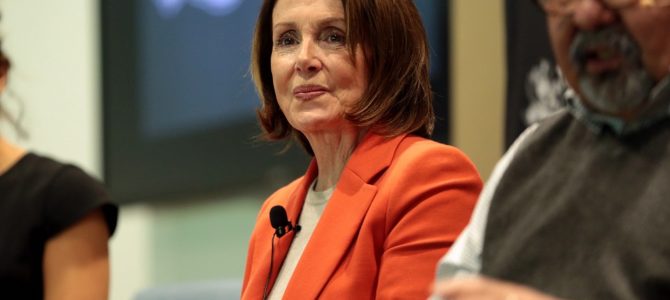
Since Jon Ossoff nearly snatched away a safe Republican congressional seat in suburban Atlanta last summer, Democrats have been certain a “Blue Wave” midterm election is coming.
Democrats are hyping every electoral pickup—an Alabama Senate seat, a close Pennsylvania congressional race, a Wisconsin supreme court justice—as proof that American voters are repelled by President Trump and will return them to power this November. A special counsel, an onscreen prostitute, and a rabid niche of anti-Trump Republicans are helping boost those prospects.
The tide seems even more favorable for Democrats as a record number of incumbent Republicans, including the speaker of the House, will not run for re-election. But less than seven months out, a strong undercurrent is pulling the Blue Wave out to political sea. A trove of new polling shows the once-formidable lead Democrats had in the generic congressional ballot is nearly gone.
Wedge issues, such as gun control and immigration, are not working in Democrats’ favor. In fact, thanks to Trump even independent voters believe Democrats are using the children of illegal immigrants for political purposes rather than legitimately protecting their welfare. Although Trump’s job approval ratings remain underwater among Democrats and Independents, voters give him props for a number of achievements, not the least of which is a strong economy, proving it is politically possible to dislike a man but like what he does.
Let’s Look at Those Polls in Greater Depth
In a Washington Post-ABC News poll released Monday, voter preference in the November election only shows a four-point lead for Democrats, of 47 percent to 43 percent among registered voters. This is a drastic drop from a 13-point advantage Democrats had at the end of last year.
There is no “enthusiasm gap” for Democrats. In fact, Republicans now seem more motivated to vote in November: 86 percent of Republicans say they are absolutely or certain to vote this fall, compared to 81 percent of Democrats.
The demographics aren’t trending blue, either. Democrats only hold a six-point lead among Independents and among the coveted age group of 18-39. Suburban voters are most likely to vote, urban voters the least likely. While white college graduates favor Democrats by nine points, non-college whites prefer a Republican congressional candidate by nearly 30 points, devastating news about a core constituency of the Democratic Party going forward.
As of now, President Trump won’t be the headwind Democrats were counting on. In a revealing question, the poll asked respondents if “supporting a candidate who shares your opinion on Donald Trump [is] important to you in the congressional election this fall?” The result was exactly the same between Republicans and Democrats: 59 percent said, yes, it’s important. Sixty-seven percent of voters age 65 and older—a group that voted for Trump over Hillary Clinton—say it’s important. And registered voters give Trump the edge in approving how he is handling the economy.
An NBC News-Wall Street Journal poll also indicates waning support for Democrats. The respondents skewed Democrat by a seven-point margin, which was the exact level of preference for a Democratic Congress, at 47 percent to 40 percent. The poll showed a big drop in the percentage of voters who want Democrats to win in order to keep tabs on Trump and the GOP. In October 2017, 46 percent said yes, they want Democrats to keep the president and Congress in check. Last week, only 40 percent agreed with that statement.
A detailed Quinnipiac University poll portends trouble for Democrats on both congressional preference and key issues. By a margin of only three points, voters want Democrats to win control of the House and Senate this year. That slim gap is within the margin of error, so it’s fair to say it’s a tie. Sixty percent of voters rate the economy as excellent or good (a slight decrease since the beginning of the year) and all voters—even Democrats—credit Trump, not Obama, with the current economy.
On the Issues, Republicans Are Pulling Even
Gun control and immigration, two hot-button issues the Democrats usually exploit to drive turn-out, might be backfiring on them. Even tariffs on Chinese goods aren’t as unpopular as Democrats and some Republicans had hoped.
Four of five Republicans and Democrats in the ABC/WP poll said supporting a candidate who shares their views on gun policy is important, and it’s more important to rural voters than to urban voters (81 percent to 74 percent). While a majority of voters in the Quinnipiac poll want tighter gun control, an overwhelming majority—including 61 percent of Democrats—opposes repealing the Second Amendment.
A slim majority also said gun violence has no effect on whether they will vote Republican or Democrat. So it looks like the nonstop media exploitation of the Parkland school shooting did not work for the Left.
The Democrats might live to regret their focus on the plight of illegal immigrants instead of on legal Americans. Nearly three-quarters agree that illegal immigration from Mexico is a serious problem and a majority support sending National Guard troops to secure the southern border. While most voters, including Republicans, agree that so-called Dreamers should be allowed to stay in the country legally, more than half think Democrats are using Dreamers for political gain.
In perhaps the most surprising result in the Quinnipiac poll, voters are split on whether Chinese imports should be hit with Trump’s proposed tariffs, even though 68 percent think a trade war with China is a bad idea. The ABC poll asked an oddly worded question—“Do you think this situation [tariffs] will be good or bad for jobs in the United States?”—and less than half thought it would be bad.
Given the outrage the media, Democrats, and many Republican have expressed on tariffs, one would expect this number to be much higher. But Americans acknowledge the unfairness in current trade policy and seem content, for now, to let the economy take a hit to restore some equity into the system.
What This Says about 2018’s Elections
So, what does this mean? Democrats need to take 24 seats from Republicans while keeping every one of their own seats to win back control of the House. The Senate map is not only hostile to Democrats, but elections in Trump-won states could lead to a larger majority for Republicans.
According to the Cook Political Report, eight Republican districts look almost certain to flip to Democrats, thanks in large part to favorable redistricting in Pennsylvania. Two open Democratic seats in Minnesota are toss-ups. Cook lists 21 current Republican seats as toss-ups, but with the exception of one (Carlo Curbelo in Fla-29), all incumbents are only within a few points, both ahead and behind, of their Democratic challengers.
Democrats seem nervous this week; their swagger is gone. Both the Washington Post and Politico had stories Tuesday about who will replace House Minority Leader Nancy Pelosi if she doesn’t win back the speaker’s gavel. (Rep. Joe Crowley of New York seems to be making his move.)
Seven months is still a long way off and anything can happen, especially when the head of one’s party is impulsive and erratic. If Trump can hold it together, the Robert Mueller probe continues to lose support among Americans, the economy chugs along, and we look tough abroad, Republicans can keep control of the House until the next presidential election. At least for now, it appears that the hundreds of political influencers who bet Trump would “ruin” the GOP and cause massive losses this November were dead flat wrong.









